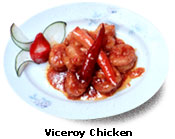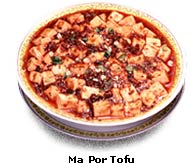|
The fiery flavors of Szechuan and Hunan
are renowned for their intensity.
|
Landlocked Hunan's chilli-rich
cuisine is similar to that of
western China's Szechuan province.
Chilli, garlic and the unusual
"strange sauce" enliven many dishes.
Mustard sauce complements duck's
tongues, and minced bean paste forms
a pungent and powdery coating for
fish or scallops. Honey sauces are
favored for desserts such as water
chestnut or cassia-flower cakes.
Hunan's range of soups includes
noodles in soup, mashed pigeon in consomme and a salty, thin version
of the West's pea soup. Although
rice is Hunan's staple,
northern-style bean-curd "bread"
rolls or dumplings and savory buns
are also popular.
|
 |
Bursting with flavor, Szechuan food
includes some of the spiciest dishes in
China, so check the chilli content on
the menu. The zest of dishes is
flavored with star anise,
fennel seed, chilli, coriander ("Chinese parsley")
and other spices. Chillied bean paste,
peppercorns and garlic are also widely
used. Chicken, pork, river fish and
shellfish are popular ingredients, and
noodles or steamed bread are preferred
to rice.
 |
Not all Szechuan cuisine is spicy.
Common cooking methods include
smoking and simmering, which allow
peppers and aromatic seasonings time
to infuse food with unforgettable
tastes and aromas. Traditional
dishes include crispy beef, deep
fried with tangy kumquat peel, and
duck, the premier Szechuan
specialty. The duck is flavored
with peppercorns,
ginger, cinnamon,
orange peel and coriander, marinated
in Chinese wine for 24 hours,
steamed for two hours, then smoked
over a charcoal fire with
camphor-wood chips and red tea
leaves added. |
|
